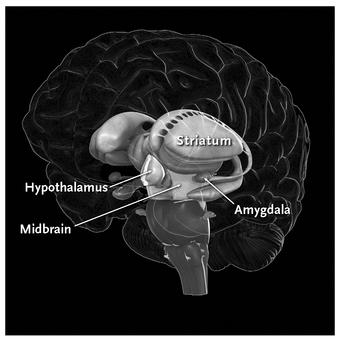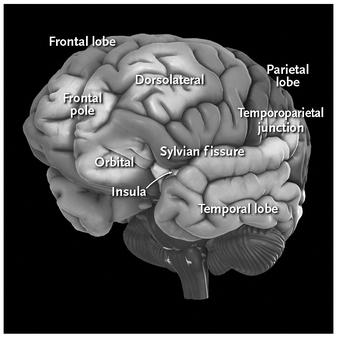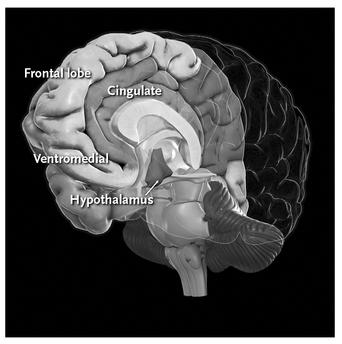The Better Angels of Our Nature: Why Violence Has Declined (112 page)
Read The Better Angels of Our Nature: Why Violence Has Declined Online
Authors: Steven Pinker
Tags: #Sociology, #Psychology, #Science, #Social History, #21st Century, #Crime, #Anthropology, #Amazon.com, #Retail, #Criminology

BOOK: The Better Angels of Our Nature: Why Violence Has Declined
10.68Mb size Format: txt, pdf, ePub
As I mentioned, predation and rage play out very differently in the behavioral repertoire of a carnivorous mammal and are triggered by electrical stimulation of different parts of the brain. Predation involves a circuit that is part of what Panksepp calls the Seeking system.
52
A major part of the Seeking system runs from a part of the midbrain (not shown in figure 8–1) via a bundle of fibers in the middle of the brain (the medial forebrain bundle) to the lateral hypothalamus, and from there up to the ventral striatum, a major part of the so-called reptilian brain. The striatum is composed of many parallel tracts (giving it a striated appearance), and it is buried deep in the cerebral hemispheres and densely connected to the frontal lobes.
52
A major part of the Seeking system runs from a part of the midbrain (not shown in figure 8–1) via a bundle of fibers in the middle of the brain (the medial forebrain bundle) to the lateral hypothalamus, and from there up to the ventral striatum, a major part of the so-called reptilian brain. The striatum is composed of many parallel tracts (giving it a striated appearance), and it is buried deep in the cerebral hemispheres and densely connected to the frontal lobes.
The Seeking system was discovered when the psychologists James Olds and Peter Milner implanted an electrode into the middle of a rat brain, hooked it up to a lever in a Skinner box, and found that the rat would press the lever to stimulate its own brain until it dropped of exhaustion.
53
Originally they thought they had found the pleasure center in the brain, but neuroscientists today believe that the system underlies wanting or craving rather than actual pleasure. (The major realization of adulthood, that you should be careful about what you want because when you get it you may not enjoy it, has a basis in the anatomy of the brain.) The Seeking system is held together not just by wiring but by chemistry. Its neurons signal to each other with a neurotransmitter called dopamine. Drugs that make dopamine more plentiful, like cocaine and amphetamines, jazz the animal up, while drugs that decrease it, like antipsychotic medications, leave the animal apathetic. (The ventral striatum also contains circuits that respond to a different family of transmitters, the endorphins or endogenous opiates. These circuits are more closely related to enjoying a reward once it arrives than to craving it in anticipation.)
53
Originally they thought they had found the pleasure center in the brain, but neuroscientists today believe that the system underlies wanting or craving rather than actual pleasure. (The major realization of adulthood, that you should be careful about what you want because when you get it you may not enjoy it, has a basis in the anatomy of the brain.) The Seeking system is held together not just by wiring but by chemistry. Its neurons signal to each other with a neurotransmitter called dopamine. Drugs that make dopamine more plentiful, like cocaine and amphetamines, jazz the animal up, while drugs that decrease it, like antipsychotic medications, leave the animal apathetic. (The ventral striatum also contains circuits that respond to a different family of transmitters, the endorphins or endogenous opiates. These circuits are more closely related to enjoying a reward once it arrives than to craving it in anticipation.)
The Seeking system identifies goals for the animal to pursue, like access to a lever that it may press to receive food. In more natural settings, the Seeking system motivates a carnivorous animal to hunt. The animal stalks its quarry in what we can imagine is a state of pleasant anticipation. If successful, it dispatches the prey in a quiet bite that is completely unlike the snarling attack of rage.
Animals can attack both in offense and in defense.
54
The simplest trigger of an offensive attack is sudden pain or frustration, the latter delivered as a signal from the Seeking system. The reflex may be seen in some of the primitive responses of a human being. Babies react with rage when their arms are suddenly pinned at their sides, and adults may lash out by swearing or breaking things when they hit their thumb with a hammer or are surprised by not getting what they expect (as in the technique of computer repair called percussive maintenance). Defensive attacks, which in the rat consist of lunging at the head of an adversary rather than kicking and biting its flank, are triggered by yet another brain system, the one that underlies fear. The Fear system, like the Rage system, consists of a circuit that runs from the periaqueductal gray through the hypothalamus to the amygdala. The Fear and Rage circuits are distinct, connecting different nuclei in each of these organs, but their physical proximity reflects the ease with which they interact.
55
Mild fear can trigger freezing or flight, but extreme fear, combined with other stimuli, can trigger an enraged defensive attack. Forward panic or rampage in humans may involve a similar handoff from the Fear system to the Rage system.
54
The simplest trigger of an offensive attack is sudden pain or frustration, the latter delivered as a signal from the Seeking system. The reflex may be seen in some of the primitive responses of a human being. Babies react with rage when their arms are suddenly pinned at their sides, and adults may lash out by swearing or breaking things when they hit their thumb with a hammer or are surprised by not getting what they expect (as in the technique of computer repair called percussive maintenance). Defensive attacks, which in the rat consist of lunging at the head of an adversary rather than kicking and biting its flank, are triggered by yet another brain system, the one that underlies fear. The Fear system, like the Rage system, consists of a circuit that runs from the periaqueductal gray through the hypothalamus to the amygdala. The Fear and Rage circuits are distinct, connecting different nuclei in each of these organs, but their physical proximity reflects the ease with which they interact.
55
Mild fear can trigger freezing or flight, but extreme fear, combined with other stimuli, can trigger an enraged defensive attack. Forward panic or rampage in humans may involve a similar handoff from the Fear system to the Rage system.
Panksepp identifies a fourth motivational system in the mammalian brain that can trigger violence; he calls it the Intermale Aggression or Dominance system.
56
Like Fear and Rage, it runs from the periaqueductal gray through the hypothalamus to the amygdala, connecting yet another trio of nuclei along the way. Each of these nuclei has receptors for testosterone. As Panskepp notes, “In virtually all mammals, male sexuality requires an assertive attitude, so that male sexuality and aggressiveness normally go together. Indeed, these tendencies are intertwined throughout the neuroaxis, and to the best of our limited knowledge, the circuitry for this type of aggression is located near, and probably interacts strongly with, both Rage and Seeking circuits.”
57
To psychologize the anatomy, the Seeking system leads a male to willingly, even eagerly, seek out an aggressive challenge with another male, but when the battle is joined and one of them is in danger of defeat or death, focused fighting may give way to blind rage. Panksepp notes that the two kinds of aggression, though they interact with each other, are neurobiologically distinct. When certain parts of the medial hypothalamus or striatum are damaged, the animal is more likely to attack a prey animal or an unwitting experimenter, but less likely to attack another male. And as we shall see, giving an animal (or a man) testosterone does not make him testy across the board. On the contrary, it makes him feel great, while putting a chip on his shoulder when he is faced with a rival male.
58
56
Like Fear and Rage, it runs from the periaqueductal gray through the hypothalamus to the amygdala, connecting yet another trio of nuclei along the way. Each of these nuclei has receptors for testosterone. As Panskepp notes, “In virtually all mammals, male sexuality requires an assertive attitude, so that male sexuality and aggressiveness normally go together. Indeed, these tendencies are intertwined throughout the neuroaxis, and to the best of our limited knowledge, the circuitry for this type of aggression is located near, and probably interacts strongly with, both Rage and Seeking circuits.”
57
To psychologize the anatomy, the Seeking system leads a male to willingly, even eagerly, seek out an aggressive challenge with another male, but when the battle is joined and one of them is in danger of defeat or death, focused fighting may give way to blind rage. Panksepp notes that the two kinds of aggression, though they interact with each other, are neurobiologically distinct. When certain parts of the medial hypothalamus or striatum are damaged, the animal is more likely to attack a prey animal or an unwitting experimenter, but less likely to attack another male. And as we shall see, giving an animal (or a man) testosterone does not make him testy across the board. On the contrary, it makes him feel great, while putting a chip on his shoulder when he is faced with a rival male.
58

One look at a human brain and you know you are dealing with a very unusual mammal. Figure 8–2, with its transparent cortex, shows that all the parts of the rat brain have been carried over to the human brain, including the organs that house the circuits for rage, fear, and dominance: the amygdala, the hypothalamus, and the periaqueductal gray (which is found inside the midbrain, lining the cerebrospinal canal running through it). The dopaminefueled striatum, whose ventral portion helps set goals for the whole brain to seek, is also prominent.

FIGURE 8–2.
Human brain, showing the major subcortical structures involved in aggression
Human brain, showing the major subcortical structures involved in aggression
Source:
3D Brain Illustration by AXS Biomedical Animation Studio, created for Dolan DNA Learning Center.
3D Brain Illustration by AXS Biomedical Animation Studio, created for Dolan DNA Learning Center.
But while these structures take up a large proportion of the rat brain, in the human brain they are enveloped by a bloated cerebrum. As figure 8–3 shows, the outsize cerebral cortex has been wrinkled like a wad of newspaper to get it to fit inside the skull. A large part of the cerebrum is taken up by the frontal lobes, which in this view of the brain extend about three-quarters of the way back. The neuroanatomy suggests that in
Homo sapiens
primitive impulses of rage, fear, and craving must contend with the cerebral restraints of prudence, moralization, and self-control—though as in all attempts at taming the wild, it’s not always clear who has the upper hand.
Homo sapiens
primitive impulses of rage, fear, and craving must contend with the cerebral restraints of prudence, moralization, and self-control—though as in all attempts at taming the wild, it’s not always clear who has the upper hand.
Within the frontal lobes, one can readily see how the orbital cortex got its name: it is a big spherical dent that accommodates the bony socket of the eye. Scientists have known that the orbital cortex is involved with regulating the emotions since 1848, when a railroad foreman named Phineas Gage tamped down some blasting powder in a hole in a rock and ignited an explosion that sent the tamping iron up through his cheekbone and out the top of his skull.
59
A 20th-century computer reconstruction based on the holes in the skull suggest that the spike tore up his left orbital cortex, together with the ventromedial cortex on the inside wall of the cerebrum. (It is visible in the medial view of the brain in figure 8–4.) The orbital and ventromedial cortex are continuous, wrapping around the bottom edge of the frontal lobe, and neuroscientists often use either term to refer to the combination of the two of them.
59
A 20th-century computer reconstruction based on the holes in the skull suggest that the spike tore up his left orbital cortex, together with the ventromedial cortex on the inside wall of the cerebrum. (It is visible in the medial view of the brain in figure 8–4.) The orbital and ventromedial cortex are continuous, wrapping around the bottom edge of the frontal lobe, and neuroscientists often use either term to refer to the combination of the two of them.

FIGURE 8–3.
Human brain, showing the major cortical regions that regulate aggression
Human brain, showing the major cortical regions that regulate aggression
Source:
3D Brain Illustration by AXS Biomedical Animation Studio, created for Dolan DNA Learning Center.
3D Brain Illustration by AXS Biomedical Animation Studio, created for Dolan DNA Learning Center.
Though Gage’s senses, memories, and movement were intact, it soon became clear that the damaged parts of his brain had been doing something important. Here is how his physician described the change:
The equilibrium or balance, so to speak, between his intellectual faculties and animal propensities, seems to have been destroyed. He is fitful, irreverent, indulging at times in the grossest profanity (which was not previously his custom), manifesting but little deference for his fellows, impatient of restraint or advice when it conflicts with his desires, at times pertinaciously obstinate, yet capricious and vacillating, devising many plans of future operations, which are no sooner arranged than they are abandoned in turn for others appearing more feasible. A child in his intellectual capacity and manifestations, he has the animal passions of a strong man. Previous to his injury, although untrained in the schools, he possessed a well-balanced mind, and was looked upon by those who knew him as a shrewd, smart businessman, very energetic and persistent in executing all his plans of operation. In this regard his mind was radically changed, so decidedly that his friends and acquaintances said he was “no longer Gage.”
60FIGURE 8–4.
Human brain, medial viewSource:
3D Brain Illustration by AXS Biomedical Animation Studio, created for Dolan DNA Learning Center.
Though Gage eventually recovered much of his equipoise, and the story has been embellished and sometimes garbled in generations of retelling to introductory psychology students, today our understanding of the function of the orbital cortex is broadly consistent with the doctor’s description.
The orbital cortex is strongly connected to the amygdala, hypothalamus, and other parts of the brain involved with emotion.
61
It is suffused with neurons that use dopamine as their neurotransmitter and that are connected to the Seeking system in the striatum. It is adjacent to an island of cortex called the insula, the front of which just barely peeks out from beneath the Sylvian fissure in figure 8–3; the rest of the insula extends back under that fissure, obscured by overhanging flaps of the frontal and temporal lobes. The insula registers our physical gut feelings, including the sensation of a distended stomach and other inner states like nausea, warmth, a full bladder, and a pounding heart. The brain takes metaphors like “that makes my blood boil” and “his behavior disgusts me” literally. The cognitive neuroscientist Jonathan Cohen and his team found that when a person feels he is getting a raw deal from another person who is dividing a windfall between them, the insula is fired up. When the stingy allocation is thought to come from a computer, so there’s no one to get mad at, the insula remains dark.
62
61
It is suffused with neurons that use dopamine as their neurotransmitter and that are connected to the Seeking system in the striatum. It is adjacent to an island of cortex called the insula, the front of which just barely peeks out from beneath the Sylvian fissure in figure 8–3; the rest of the insula extends back under that fissure, obscured by overhanging flaps of the frontal and temporal lobes. The insula registers our physical gut feelings, including the sensation of a distended stomach and other inner states like nausea, warmth, a full bladder, and a pounding heart. The brain takes metaphors like “that makes my blood boil” and “his behavior disgusts me” literally. The cognitive neuroscientist Jonathan Cohen and his team found that when a person feels he is getting a raw deal from another person who is dividing a windfall between them, the insula is fired up. When the stingy allocation is thought to come from a computer, so there’s no one to get mad at, the insula remains dark.
62
Other books
Dance of the Bones by J. A. Jance
Taking Flight by Solmonson, Sarah
The Road to Hell by Michael Maren
Taken (Breaking the Darkness) by Starr, Felicia
Turbulence by Jessica Matthews
Tree of Smoke by Denis Johnson
The Northern Clemency by Philip Hensher
The Goblin's Curse by Gillian Summers
The Boy Who Could Fly Without a Motor by Theodore Taylor
Valentine Vegas Gigolo Sheikh by Teresa Morgan
